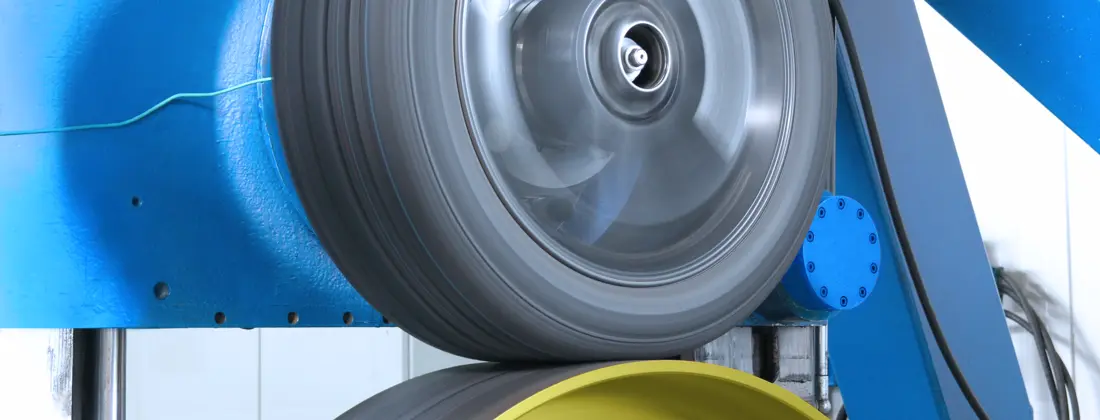EN 14251 Tyre Braking Distance Wet Grip Test
The EN 14251 standard specifies the procedure for determining the braking distance of tyres on wet surfaces under controlled conditions. This test is crucial in ensuring that tyres meet the minimum safety requirements set by regulatory bodies across Europe and beyond. By simulating real-world driving scenarios, this testing ensures tyre performance meets stringent criteria related to wet grip, aquaplaning resistance, and lateral stability.
The procedure involves a series of controlled tests where each tyre is subjected to braking in a specified water depth under standard conditions. The test apparatus includes an automated vehicle for consistent speed control and precise measurement. Specimen preparation focuses on ensuring the tyres are in optimal condition before testing, which includes proper inflation pressure, clean surfaces, and consistent tread depth.
The test results provide critical data that can influence tyre design, manufacturing processes, and market compliance. Compliance with this standard is essential for manufacturers to ensure their products meet regulatory requirements and consumer expectations regarding safety and performance.
Here are the key steps involved in conducting an EN 14251 brake test:
- The tyres undergo a preliminary inspection to confirm they meet all specified criteria.
- A calibrated water tank is used to simulate wet road conditions, with a standard depth of 3 mm of standing water.
- An automated vehicle drives at a constant speed on the track, and braking starts when it reaches a defined point.
- The distance from the start point to where the tyre comes to rest after complete deceleration is measured accurately.
For compliance with this test, tyres must meet specific criteria for both stopping distances (braking distance) and speed. The results are typically reported in meters and can be compared against other brands or previous iterations of a model to assess performance improvements or shortcomings.
| Standard Number | Title |
|---|---|
| EN 14251:2017 | Tyres—Determination of braking distance in a wet environment |
Why It Matters
The EN 14251 tyre braking distance test is critical for ensuring that tyres perform safely and effectively under challenging conditions, such as when driving on wet roads. This test helps manufacturers identify areas where improvements can be made to enhance the safety of their products.
By participating in this testing procedure, manufacturers demonstrate their commitment to compliance with international standards and improve consumer confidence. The results from these tests are also valuable for regulatory bodies seeking to ensure that tyres meet minimum performance requirements.
The implications extend beyond just meeting legal obligations; they encompass enhancing brand reputation through superior product performance and reliability. Safety is paramount in the automotive industry, and tests like EN 14251 play a vital role in protecting both drivers and pedestrians from potential hazards on wet roads.
- Enhances safety for all road users
- Promotes compliance with international standards
- Improves brand reputation through superior product performance
- Ensures consistent quality across production batches
Applied Standards
| Standard Number | Title |
|---|---|
| EN 14251:2017 | Tyres—Determination of braking distance in a wet environment |
| ISO 6938-1 | Rubber and plastics products—Testing methods for tyres and tyre components—Part 1: General requirements and definitions |
The EN 14251 standard is complemented by ISO standards that provide broader context on testing procedures applicable to rubber and plastic materials used in tyre construction. These international guidelines ensure uniformity across the industry, reinforcing the reliability of test results.
Customer Impact and Satisfaction
- Safety: Ensures that tyres perform reliably on wet roads, reducing accidents caused by hydroplaning or poor braking performance.
- Consumer Confidence: Demonstrates adherence to international standards, building trust among consumers.
- Market Compliance: Helps manufacturers meet regulatory requirements and avoid costly recalls.
- R&D Innovation: Provides data for continuous improvement in tyre design and manufacturing processes.
Customer satisfaction is paramount. By participating in this rigorous testing process, manufacturers can ensure their products are not only safe but also exceed expectations in terms of performance and reliability. This approach fosters long-term customer loyalty and builds a strong market position.





